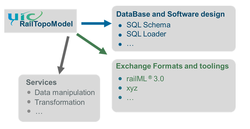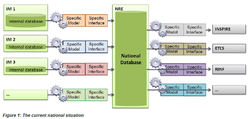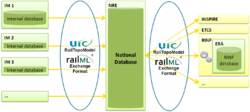RTM for your business: Difference between revisions
| [checked revision] | [checked revision] |
(adding intro and lessons learned) |
m (wording) |
||
| Line 1: | Line 1: | ||
{{Under Construction}}<br /> | {{Under Construction}}<br /> | ||
{{Overview|text=This | {{Overview|text=This chapter gives you an overview about RailTopoModel. It explains what RTM is all about, why and how it has been developed, and what it is used for. It further answers the question why you should prefer RTM compared to proprietary solutions within your company.}}<br /> | ||
[[File:RTMSchema.png|thumbnail|250px|RTM components (© RTM Expert Group)]] | [[File:RTMSchema.png|thumbnail|250px|RTM components (© RTM Expert Group)]] | ||
RailTopoModel is a universal railway infrastructure model, intended to serve any related business purpose. RailTopoModel aims to define railway objects and events in a standard form (UML), to describe how they interact with each other, and how they are expected to be used. By standardizing the data structure to be used for the railway network, it contributes to the standardizing of software and data flows in the railway industry.<br /> | RailTopoModel is a universal railway infrastructure model, intended to serve any related business purpose. RailTopoModel aims to define railway objects and events in a standard form (UML), to describe how they interact with each other, and how they are expected to be used. By standardizing the data structure to be used for the railway network, it contributes to the standardizing of software and data flows in the railway industry.<br /> | ||
Revision as of 18:32, 12 April 2016
|
|
RailTopoModel is a universal railway infrastructure model, intended to serve any related business purpose. RailTopoModel aims to define railway objects and events in a standard form (UML), to describe how they interact with each other, and how they are expected to be used. By standardizing the data structure to be used for the railway network, it contributes to the standardizing of software and data flows in the railway industry.
One of the first deliverables based on RailTopoModel will be an enhanced version of the standard exchange format railML, with the announcement of railML3.0.
Motivation
One of the greatest challenges for today’s railway sector is to establish a format and mechanism to transfer data, both internally across an organisation and externally between organisations. This has arisen from the lack of a standardised data exchange format and a single, industry-wide approach.
To date, there has been little coordination or consensus within the railway community over a standard for the exchange of data. Thus multiple standards have been developed for specific purposes, each with its own data definition (model) and file format (2).
The consequences of this have been:
- Labour-intensive, repetitive developments in IT,
- Long project lead times, and
- Incompatibility between different standards, which has prevented the development of transformation software in a competitive market.
Consequentially, each data model and format cannot be used for purposes other than the original one. Examples include formats designed for RINF, INSPIRE, ETCS projects, etc.
A standardised model
The vision for a standardised data exchange process requires a number of components:
- A logical model: to describe the topological relationship of infrastructure objects, and their attributes.
- An exchange format: to represent objects within a model as structured data, typically in text format with a defined schema.
- An adaptor / translator: to restructure data from one format to another. Translators can be used to convert the output of platform specific data to a standardised format which can then be shared more readily with other applications.
Together, these components will provide a data exchange toolset that can facilitate the efficient transfer of data within the rail sector. They will allow users to exchange tabular and geographical data related to all aspects of the rail sector, from infrastructure description and status, interlocking and routes, timetabling and traffic control etc. using a standardised format.
Considering the work done by the railML® initiative project in co-operation with this modelling work, there are currently two products available to facilitate the exchange of data in the domain of railway infrastructure.
| Logical model | The RailTopoModel is a generic railway data model designed to support current and future business needs. It is particularly useful for:
|
| railML | railML 3 is the latest evolution of the format created by railML.org. RailML 3 was specifically developed to compliment the RailTopoModel. |
Thus, railML® can be viewed as the first benefit of RailTopoModel.
Benefits from a standardised model
Investing in a standardised railway data exchange format will provide multiple benefits for the sector, including:
- Improved data quality, by avoiding losses or mismatches;
- More efficient business performance, by reducing lead times and overhead in data transformation;
- Streamlined and re-usable development, by providing a universal data structure and clarifying its semantics;
- Integrated IT systems, by providing standard interfaces for data exchange.
A significant return on investment can be expected. Detailed Information about railML® can be found on the railML® website.
Goals
The ultimate goal is to propose a standardized infrastructure master model which supports a common representation of a railway network and events, and facilitates the exchange of data within the rail sector.
For this purpose, UIC proposes the use of a graph topological model, as such a model is commonly used to display networks for a range of sectors, including railways. One of the main reasons for its wide past adoption is that a graph model is systemic, i.e. it is independent of any particular use or application. This choice guarantees sustainability and scalability, meaning that the Model can evolve as business needs change. It also ensures the integrity, quality and dimension of data is not compromised due to the usages and evolutions.
The first objective is to ensure that this model supports the railway business needs, today and tomorrow. In order to achieve this, the model must fulfil the following criteria:
- Provide a topological representation of the iron network which is fully connected and can be visualised schematically. It must display the track location at the most detailed level, and it mist be able to visualize the connections that exist at other scales (= levels of detail), such as "line" and "corridor".
- Enable data to be aggregated and disaggregated, to make sure that consistency is retained across all scales.
- Allow permitted routes to be identified, based on network topology and the location and rules of signaling assets etc.
- Support multiple referencing systems, ensuring consistency during transformation. Primary examples include:
- Linear referencing – using mileposts and ‘rail addresses’,
- Positioning using geographic reference systems,
- Screen (schematic) coordinates.
- Locate point and linear entities, including:
- Points / nodes, such as any installation, equipment, event, etc.
- Lines / edges, such as speed limits, slopes, platforms, etc. (attributes which are the same along a linear feature).
- Areal objects, such as track circuits, tunnels etc.
Finally, it is important to future-proof the model. This model is designed to be enriched progressively, per layer, with new concepts to support business usages as they evolve.
History
The RailTopoModel initiative originates from a small group of EIM/CER representatives involved in the European Register of Infrastructure ("RINF") project with the European Railway Agency (ERA), or local ETCS works with industrial partners, or dealing with requests by Inspire EU directive, and other similar activities.
In 2012, these actors shared the fact that the whole sector is permanently facing the two following issues:
- Repetitive development of multiple flows of infrastructure data exchange with all kinds of partners;
- Difficulties to manage both concepts of "network routes" and "infrastructure equipment and characteristics" in a unique set of data.
This shared observation, enriched with some local initiatives, has led to the creation of a working group whose aim was to design a robust model to support these needs, and which could evolve over time.
Considering the ambition of this group and the expected benefits to the whole community, UIC was asked to support this initiative and make it publicly available.
At the same time, the same group of EIM/CER representatives, as contributors to the RINF project, proposed ERA to enhance the RINF data model to include route topology, in order to support future business use cases to “find the possible routes compatible with given train characteristics”.
In August 2012, during a RINF project meeting, ERA organised a presentation by the railML organisation to propose the railML standard as a possible solution to exchange of data in the RINF project.
Ccollaboration between the RailTopoModel working group, and railML.org which was also facing limitation on its current solution to support network topology stemmed from this meeting. The collaboration between these two teams will lead to the delivery of a consistent set of solutions, consisting in a data model and a matching data exchange format.
RailTopoModel and railML are two separate initiatives that, although complementary, will remain separate:
- RailTopoModel is defined as a public good, designed by the railway community to support their long term needs. As such, it should and will remain independent of any usage.
- RailML is one use case of RailTopoModel, supported by an open source community, and driven by their interest and priorities.
Feasibility Study
Before launching the RailTopoModel project, a feasibility study was performed by TrafIT on behalf of UIC. The results were presented at a UIC conference in Paris on 17 September 2013 and then published in a PDF.
The output of this work was a schema for an ‘off the shelf’ network model which describes the topology and basic elements of a railway’s iron network, and related assets such as track, signals etc. The model, or graph, should be designed to be independent of any particular usage, and can therefore be used for multiple applications.
The vision is for this model to be adopted by users from the rail sector to design future applications, and as a first deliverable to support the exchange of data within and between organisations. The study found that it was indeed achievable, and put together a roadmap for successful implementation.
RTM vs. other models
Transmodel and RailTopoModel are both Conceptual Models dedicated to transportation infrastructure and services. The main difference between these two models is the business and functional domain of coverage.
Transmodel is a European standard data model for public transport, designed to cover the multiple transportation means (bus, tramway, trains,…) in terms of interoperability, and the places where they meet each other (e.g. stations, cities, towns, villages). Its aim is to support operations, and more precisely scheduling and journey planning.
RailTopoModel has been developed for the specific needs of the railway sector, to precisely and consistently model network topology, rail infrastructures, and all railways objects and events, at any level of detail that may be required (track, line, corridors,…).
What you should have learned
|
| Back To | Previous Chapter | Next Chapter |
|---|---|---|
| RTM Quick Start | - | RTM For Developers |


